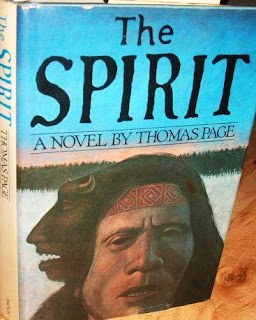But Bigfoot was dead and gone by the '80s—I was just too old for 1987's Harry and the Hendersons—and although he's back in a big way today, I can't say I have any interest in him. So it was with some measure of "meh" that I approached The Spirit, a 1977 novel actually published in hardcover (scroll down for cover). Ballantine released the paperback edition in 1978 with a moody George Ziel cover, as he does so well, and I was sort of expecting an adventure-romance tinged with creature horror. Author Thomas Page (b. 1942, Washington DC) wrote a few other genre paperbacks in the day that I've seen here and there over the years but I know nothing about him. I do know he can spin a yarn and mix in some solid suspense and a few snatches of 'Squatch destruction.
There is something I think distasteful about implying Bigfoot is dangerous to humans, I've always felt, but now I see he is generally part of the "eco-horror" moment of that era, when the natural world has simply had enough of humans trashing it for big bucks and fights back by any means necessary. Bigfoot simply does not respond well to ski resorts in his 'hood! Page's novel, despite the slavering back-cover copy and its swooning-romance cover, is more tasteful than those pulp implications, as its specific horror elements are minimal and there is no romantic element whatsoever, which is a shame because two characters meet cute and I could've done with some sexy Seventies sex action.
Still, I do think Spirit is a rewarding little read for those who dig the 'foot, as it has some terrific action setpieces and opens with a harrowing helicopter crash, characters and dialogue aren't a lot more than stock but serve adequate purpose for the story. Page isn't too shabby at mixing in Native American lore either, adding a dash of the hallucinating Vietnam vet and the vision quest, and has some fun theorizing on the anthropological origins of the creature (genetic deformity? cross-species banging?), thanks to our manly-man protagonist's visits to a primate specialist. Bigfoot sightings aren't overdone and have a bit of subtlety about them—She had materialized from the forest, as massive as a mountain and light as a wraith—but definitely convey the creatures' power and might. There's even sad note of irony at the end.
But only dum-dum Lester, who works in the ski lodge kitchen and knows what he saw that one eerie night even though everyone thinks he made it up and he tries to recant even though he really wants to make some money off it on the Johnny Carson show, truly knows what's up with the 'Squatch:
1977 US hardcover, Rawson Associates
Easily the most accurate cover art
Still, I do think Spirit is a rewarding little read for those who dig the 'foot, as it has some terrific action setpieces and opens with a harrowing helicopter crash, characters and dialogue aren't a lot more than stock but serve adequate purpose for the story. Page isn't too shabby at mixing in Native American lore either, adding a dash of the hallucinating Vietnam vet and the vision quest, and has some fun theorizing on the anthropological origins of the creature (genetic deformity? cross-species banging?), thanks to our manly-man protagonist's visits to a primate specialist. Bigfoot sightings aren't overdone and have a bit of subtlety about them—She had materialized from the forest, as massive as a mountain and light as a wraith—but definitely convey the creatures' power and might. There's even sad note of irony at the end.
1979 Hamlyn UK paperback
But only dum-dum Lester, who works in the ski lodge kitchen and knows what he saw that one eerie night even though everyone thinks he made it up and he tries to recant even though he really wants to make some money off it on the Johnny Carson show, truly knows what's up with the 'Squatch:
Somebody once said on a late-night TV show that people were afraid of the full moon because thousands of years ago the earth was covered with different types of humans who came out then. These humans lived in the woods with saber-toothed tigers and snakes and dinosaurs and mastodons, and got along great with them because they all ate the same thing: other humans.
Berkley Books, 1977, rare collectible
Er, no thanks, I'm good





















